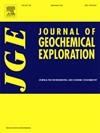Provenance analysis signposts for sedimentary uranium exploration in aeolian sandstone systems: Insights from the Luohe Formation, Western Ordos Basin
IF 3.4
2区 地球科学
Q1 GEOCHEMISTRY & GEOPHYSICS
引用次数: 0
Abstract
The Lower Cretaceous Luohe Formation in the western Ordos Basin, North China, represents a rare aeolian sedimentary system with distinctive “uranium-bearing” characteristics. Sedimentary source of the uranium-bearing sandstones in this formation, which is crucial for advancing uranium exploration efforts, remains ambiguous. This study undertakes a comprehensive investigation encompassing petrology, geochemistry, and detrital zircon systematics (including zircon U–Pb ages, trace elements, and Hf isotopes) on the aeolian sandstones of the Luohe Formation within the western Ordos Basin. The objective is to provide crucial insights into conventional exploration for sedimentary uranium resources within aeolian sedimentary systems in intracontinental basins. Detrital zircon ages are categorized into a predominant age grouping within the Phanerozoic era (210–450 Ma), with notable peaks observed at 260 Ma and 420 Ma. Additionally, two minor age clusters are identified in the Early Paleoproterozoic (2240–2600 Ma), notably peaking at 2460 Ma, and the Late Paleoproterozoic (1600–2150 Ma), with a peak observed at 1850 Ma. Integrating the geochemical discrimination diagrams, it is suggested that the Alxa Block to the west of the Ordos Basin serves as the main provenance supplier of the hard detrital zircons. The uranium-bearing debris from the Alxa Block underwent sedimentary recycling and, therefore, were transported to the paleouplifts that formed on the western Ordos Basin during the Late Jurassic to Early Cretaceous. The paleoclimatic conditions characterized by prolonged arid periods interspersed with brief humid and warm episodes are crucial for the unique “uranium-bearing” nature of the sandstones. The sedimentary environment, dominated by aeolian deposition with localized fluvial deposition at basin-mountain interfaces, is identified as an ideal setting for uranium storage within aeolian sedimentary systems. We finally propose a generalized approach for exploring uranium reservoirs in aeolian sandstone systems at the basin level.

风成砂岩体系沉积铀矿物源分析标志——来自鄂尔多斯盆地西部漯河组的启示
鄂尔多斯盆地西部下白垩统漯河组是一种罕见的具有鲜明“含铀”特征的风成沉积体系。该组含铀砂岩的沉积来源是推进铀矿勘探工作的关键,但目前尚不清楚。本文对鄂尔多斯盆地西部洛河组风成砂岩进行了岩石学、地球化学和碎屑锆石系统(包括锆石U-Pb年龄、微量元素和Hf同位素)的综合研究。目的是为大陆内盆地风成沉积体系内沉积铀资源的常规勘探提供重要见解。显生宙(210 ~ 450 Ma)为主要锆石年龄组,260 Ma和420 Ma为锆石年龄高峰。此外,在早古元古代(2240 ~ 2600 Ma)和晚古元古代(1600 ~ 2150 Ma)中发现了两个较小的年龄群,其中2460 Ma为高峰,1850 Ma为高峰。综合地球化学判别图,认为鄂尔多斯盆地西部的阿拉善地块是硬碎屑锆石的主要物源。阿拉善地块的含铀碎屑经过沉积再循环作用,被输送到鄂尔多斯盆地西部晚侏罗世至早白垩世形成的古隆起中。长时间的干旱期穿插着短暂的湿润和温暖期的古气候条件对砂岩独特的“含铀”性质至关重要。该沉积环境以风成沉积为主,在盆山界面处有局部的河流沉积,是风成沉积体系中铀储存的理想环境。最后,我们提出了一种在盆地水平上寻找风成砂岩体系铀矿的通用方法。
本文章由计算机程序翻译,如有差异,请以英文原文为准。
求助全文
约1分钟内获得全文
求助全文
来源期刊

Journal of Geochemical Exploration
地学-地球化学与地球物理
CiteScore
7.40
自引率
7.70%
发文量
148
审稿时长
8.1 months
期刊介绍:
Journal of Geochemical Exploration is mostly dedicated to publication of original studies in exploration and environmental geochemistry and related topics.
Contributions considered of prevalent interest for the journal include researches based on the application of innovative methods to:
define the genesis and the evolution of mineral deposits including transfer of elements in large-scale mineralized areas.
analyze complex systems at the boundaries between bio-geochemistry, metal transport and mineral accumulation.
evaluate effects of historical mining activities on the surface environment.
trace pollutant sources and define their fate and transport models in the near-surface and surface environments involving solid, fluid and aerial matrices.
assess and quantify natural and technogenic radioactivity in the environment.
determine geochemical anomalies and set baseline reference values using compositional data analysis, multivariate statistics and geo-spatial analysis.
assess the impacts of anthropogenic contamination on ecosystems and human health at local and regional scale to prioritize and classify risks through deterministic and stochastic approaches.
Papers dedicated to the presentation of newly developed methods in analytical geochemistry to be applied in the field or in laboratory are also within the topics of interest for the journal.
 求助内容:
求助内容: 应助结果提醒方式:
应助结果提醒方式:


